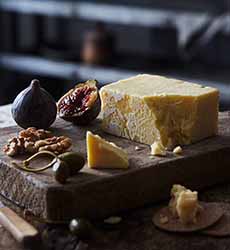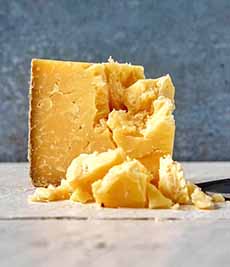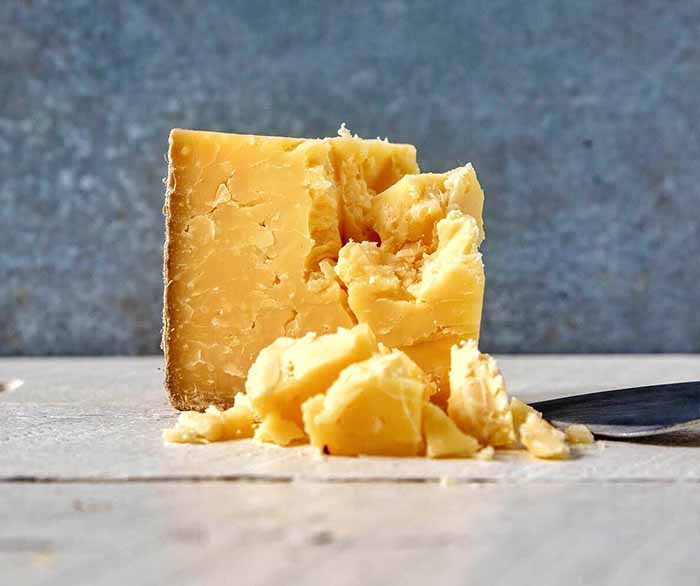Ivy’s Reserve Vintage Cheddar From Somerset, England
|
We first learned about Ivy’s Reserve Vintage Cheddar‡‡‡ when Wyke Farms, the U.K.’s largest independent cheese producer and producer of renewable energy, wrote to tell us that its prize-winning Ivy’s Reserve Vintage Cheddar has been certified as the world’s first carbon-neutral Cheddar. The certification shows consumers that a company has measured and offset its entire carbon footprint, and that it’s working to reduce future emissions*. First, hats off to Wyke Farms. Producing carbon-neutral food is one thing that manufacturers can do to fight climate change, and you’ll be seeing more brands jumping on the rather-essential bandwagon. For sheer deliciousness, Ivy’s Reserve Vintage Cheddar is also our Top Pick Of The Week. Since 1861, Wyke Farms has been making cheese and butter with milk from grass-fed cows grazing the lush pastures of the Mendip Hills† in the center of the Cheddar making region in Somerset, England. The milk used to produce their Cheddar is cultured with vegetarian rennet and is hormone- and rBST-free. Their cheeses have won more national awards in the U.K. than any other farmhouse Cheddar. What’s the difference between farmhouse Cheddar and simply, Cheddar? What distinguishes farmhouse Cheddar from the mass-produced Cheddar (a.k.a. “factory Cheddar”) starts with the raw ingredients. The best producers use milk from grass-fed cows that produce good levels of fat and protein. Such producers stop using the cows’ milk for their farmhouse cheese once cows are brought indoors for wintering on silage. The company chose its flagship Ivy’s Reserve Vintage Cheddar as the first product to be certified carbon neutral. It also is shipped in vacuum-packed containers that do not require refrigeration. > The history of Cheddar cheese. > The different types of cheese. Do you like your Cheddar strong and full-flavored, with crunchy calcium lactate** crystals? Then you’ll want to get your hands on some Ivy’s Reserve Vintage Cheddar as soon as possible. Made in the prime Cheddar-making region of Somerset, England, this beautiful Cheddar is aged up to 18 months. The result is creaminess, tiny bits of crunchiness (tyrosine crystals†), complexity of flavor, and a nutty, rounded finish. The award-winning Cheddar is named after Grandmother Ivy, who founded the dairy with her husband in 1861. Beyond the care taken to produce the company’s other Cheddars, Ivy’s Reserve is made with a secret recipe. Grandma Ivy wrote it down—and thank goodness, since for most of human history, and even into the last century, recipes were only memorized. That’s because most people could not read and write. Ivy’s recipe is now kept locked in a safe on the farm. For many years, this special cheese was only made as Christmas gifts for family and friends. But demand grew, and ultimately, it was made commercially. Not surprisingly, demand continues to grow—which you’ll understand as soon as you taste it. Ivy’s Reserve is matured for 18 months under wood†† to bring out an unmatched “rounded” flavor profile. Slightly sweet, nutty, and complex, the rich flavor and sharp tang are followed by a lasting mellowness. This award-winning Cheddar cheese is everything that a Cheddar from Somerset, the home of Cheddar, should be. We love the tiny white crunchy bits in the paste of the cheese. They’re calcium lactate crystals, which can form as the cheese ages and can also appear as a white film or white deposits on the outside of the cheese**. Less experienced cheese eaters often mistakenly identify it/them as mold. They are completely harmless when eaten and are considered a sign of a quality, well-aged cheese with good flavor. Distribution is expanding as we write. Ivy’s Reserve is available in packs of 1.1lb (500g) in some branches of Costco and Sam’s Club. But you can purchase it online at iGourmet. Check with other cheese purveyors. Grandmother Ivy used to say, “if you look after nature then nature will look after you.” She had the deepest respect for nature and a love for the countryside. Ivy’s Reserve is produced respectfully adhering to her century-old principles. She would undoubtedly be very pleased with the carbon-neutral (PAS 2060) certification. And you will undoubtedly be very pleased with Ivy’s Vintage Reserve Cheddar. Wyke Farms Ltd is a family run company set in the heart of England’s Somerset County in South West England, long known for its fine Cheddar cheeses. It contains the village of Cheddar, which gave its name to the cheese. The mild Somerset climate, with long summer days and rain showers, creates lush grass. That grass, in turn, helps to make the local milk particularly rich and creamy. In Somerset, the art of traditional cheese making has been practiced by the Clothier family since 1861, started by Ivy and Tom Clothier and a family recipe for Cheddar. Three generations later, grandsons Richard and Tom run the cheese-making operations with their father John, while grandsons David and Roger run the family dairy farming operations. Today, Wyke Farms is one of the largest independent cheese makers and milk processors in the U.K., producing more than 16,000 tons of Cheddar per year. Wyke Farms Cheddar is sold throughout the U.K. and in 160 countries worldwide. Different types of Cheddar—Mature, Extra Mature, Vintage, and Ivy’s Vintage Secret Recipe—have been made using the same award-winning 160-year-old recipe. (Wyke Vintage Reserve is matured for 15 months, not to be confused with the 18-month-matured, carbon-neutral Ivy’s Vintage Reserve Cheddar). The cheese is aged in wooden maturing boxes†† and is constantly monitored by a master cheese grader until it is ready for release. Wyke Farms has worked closely with Carbon Trust, the world’s leading independent certification body for carbon footprints, to meet the British PAS 2060‡ requirements to qualify for carbon neutral status. For more information visit WykeFarms.com. ________________ *Companies purchase carbon offsets to achieve carbon neutrality. Here’s more about it. |
|
|
|
†The caves of the Mendip Hills were settled during the Palaeolithic Period, some 2.58 million years ago. The onset of the Paleolithic Period coincides with the first evidence of tool construction and use by man. The Mendip Hills caves contain extensive archaeological sites. Bones from one cave have been dated to 12,000 B.C.E., and a complete skeleton, known as Cheddar Man, dates from 7150 B.C.E. [source]. **Calcium lactate crystals cause the powdery white “film” or “smear” on the surface of fully aged, mature cheeses including Cheddar. Tyrosine crystals are the tiny white crunchy bits in the paste of the cheese. They form when proteins in the cheese break down and begin to unravel during the aging process. Amino acids called tyrosines are released and cluster together into hard crystals. Here’s more about them. ‡The PAS 2060 is an internationally recognized specification for carbon neutrality and sets requirements for quantification, reduction and offsetting of greenhouse gas emissions for organizations, products and events. ††For centuries or longer, artisan cheeses have been placed onto wooden boards in an aging room. Many kinds of cheese—including Beaufort, Cheddar, and Parmigiano Reggiano—are aged this way. Sometimes, wooden molds or boxes are used as well. During the aging process, distinctive flavors and textures develop; and for most cheeses, a rind forms. These developments are abetted by benign bacteria that grow and contribute to the cheese’s flavor. ‡‡‡Why is Cheddar capitalized? Because it’s the name of a village in England. Those geographic locales that give their name to products are capitalized—Asiago, Brie, Edam, Gouda, Gorgonzola, Munster, Stilton, etc. American cheese is, naturally, capitalized. If the cheese is generic, e.g. blue cheese, feta, goat cheese, mozzarella.
|
||







